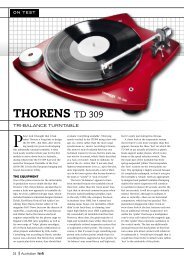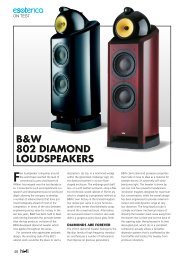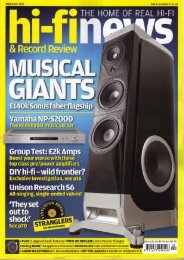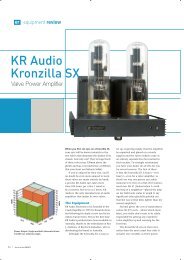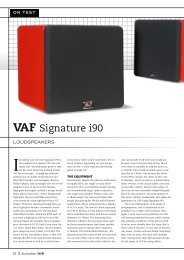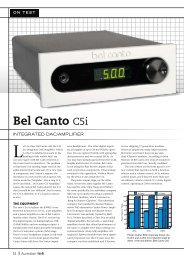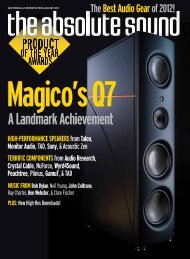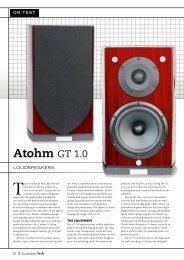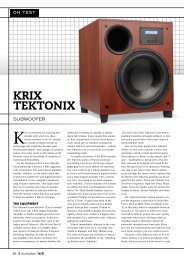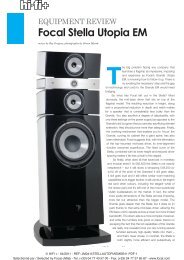here - Ultra High-End Audio and Home Theater Review
here - Ultra High-End Audio and Home Theater Review
here - Ultra High-End Audio and Home Theater Review
Create successful ePaper yourself
Turn your PDF publications into a flip-book with our unique Google optimized e-Paper software.
Mystère CA21 Preamplifier <strong>and</strong> PA21 Power Amplifier<br />
On TEST<br />
dBFS<br />
0.00<br />
-20.00<br />
-40.00<br />
-60.00<br />
-80.00<br />
-100.00<br />
-120.00<br />
-140.00<br />
dBFS<br />
0.00<br />
-20.00<br />
-40.00<br />
-60.00<br />
-80.00<br />
-100.00<br />
-120.00<br />
-140.00<br />
dBFS<br />
0.00<br />
-20.00<br />
-40.00<br />
-60.00<br />
-80.00<br />
-100.00<br />
-120.00<br />
-140.00<br />
Distortion was very low for a valve amplifier<br />
<strong>and</strong> quite low compared to quite a few solidstate<br />
amplifiers that don’t use negative feedback<br />
0.00 Hz 4000.00 8000.00 12000.00 16000.00 20000.00<br />
Graph 1: Total harmonic distortion (THD) at 1kHz referenced to 1-watt across an 8 ohm noninductive<br />
load, using 8-ohm output transformer tap. [Mystere C21/P21 Pre/Power Amplifiers]<br />
Newport Test Labs<br />
Newport Test Labs<br />
0.00 Hz 4000.00 8000.00 12000.00 16000.00 20000.00<br />
Graph 2: Total harmonic distortion (THD) at 1kHz referenced to 1-watt across a 4-ohm<br />
non-inductive load, using 8-ohm output transformer tap. [Mystere C21/P21 Pre/Power Amplifiers]<br />
Newport Test Labs<br />
0.00 Hz 4000.00 8000.00 12000.00 16000.00 20000.00<br />
Graph 3: Total harmonic distortion (THD) at 1kHz referenced to rated output (50-watts) across an<br />
8-ohm non-inductive load using 8-ohm output transformer tap [Mystere C21/P21 Pre/Power Amps]<br />
dBFS<br />
0.00<br />
-20.00<br />
-40.00<br />
-60.00<br />
-80.00<br />
-100.00<br />
-120.00<br />
-140.00<br />
dBFS<br />
0.00<br />
-10.00<br />
-20.00<br />
-30.00<br />
-40.00<br />
-50.00<br />
-60.00<br />
-70.00<br />
-80.00<br />
-90.00<br />
-100.00<br />
-110.00<br />
-120.00<br />
dBr<br />
3.00<br />
2.00<br />
1.00<br />
0.00<br />
-1.00<br />
-2.00<br />
-3.00<br />
Newport Test Labs<br />
0.00 Hz 4000.00 8000.00 12000.00 16000.00 20000.00<br />
Graph 4: Total harmonic distortion (THD) at 1kHz at 54-watts) across a 4-ohm non-inductive load,<br />
using 8-ohm output transformer taps. [Mystere C21/P21 Pre/Power Amplifiers]<br />
Newport Test Labs<br />
0.00 Hz 4000.00 8000.00 12000.00 16000.00 20000.00 24000.00 28000.00<br />
Graph 5: Intermodulation distortion (CCIF-IMD) using test signals at 19kHz <strong>and</strong> 20kHz, referenced<br />
to a 1-watt output (at 0dB) across an 8-ohm non-inductive load. [Mystere C21/P21 Pre/Power]<br />
Newport Test Labs<br />
10.00 Hz 100.00 1000.00 10000.00 30000.00<br />
Graph 6: Frequency response of line input referenced to a 1 watt output (at 0dB) across an<br />
8-ohm non-inductive load (Black Trace) <strong>and</strong> across a combination resistive/inductive/capacitive<br />
load representative of a typical two-way loudspeaker system (Red Trace). [Mystere C21/P21]<br />
to a load that simulates that of a two-way<br />
bookshelf loudspeaker. (Editor’s Note: As it<br />
happens, it’s exactly the same load used by<br />
US magazine Stereophile, which is a customisation<br />
of a circuit originally developed<br />
by Ken Kantor <strong>and</strong> the conclusion of an<br />
interview with Kantor that commenced in<br />
the last issue of Australian Hi-Fi Magazine,<br />
appears in this very issue, on page 32!) You<br />
can see that into such a load, the response<br />
varies quite a bit, though the extent is<br />
exaggerated by the graph’s extreme vertical<br />
scale. In fact, the frequency response, even<br />
into this simulated loudspeaker load, is still<br />
an excellent 20Hz to 20kHz ±1.5dB.<br />
Channel balance was inspiringly good,<br />
at 0.7dB (at 1kHz) <strong>and</strong> channel separation<br />
was also good, particularly at low frequencies<br />
(95dB at 20Hz, <strong>and</strong> still 81dB at 1kHz).<br />
It diminished at higher frequencies, though<br />
the measured result of 54dB at 20kHz is<br />
more than is necessary to deliver not only<br />
adequate channel separation, but also<br />
realistic stereo imaging. Inter-channel phase<br />
errors were about what I’d expect for a<br />
valve amplifier, though the figure of 9.4° at<br />
20kHz is a bit high: It would, however, be<br />
completely inaudible.<br />
Distortion was very low for a valve<br />
amplifier (<strong>and</strong> quite low compared to quite<br />
a few solid-state amplifiers, particularly<br />
those that don’t employ negative feedback).<br />
At an output of one watt into 8Ω<br />
the spectral analysis (Graph 1) shows just<br />
second, third <strong>and</strong> fourth harmonics, at<br />
–65dB (0.056%THD), –70dB (0.031%) <strong>and</strong><br />
CONTINUED ON PAGE 71<br />
43



